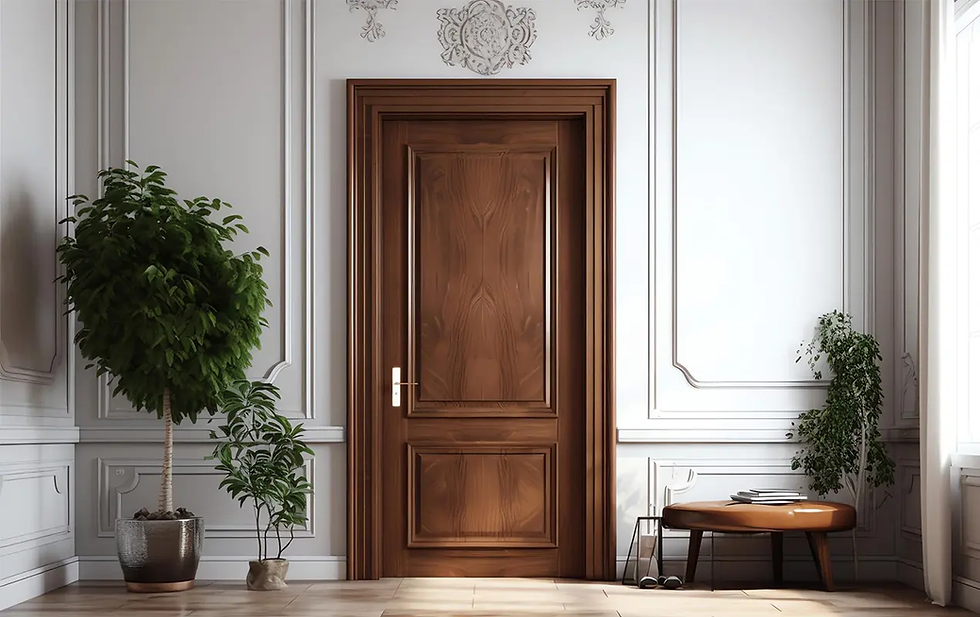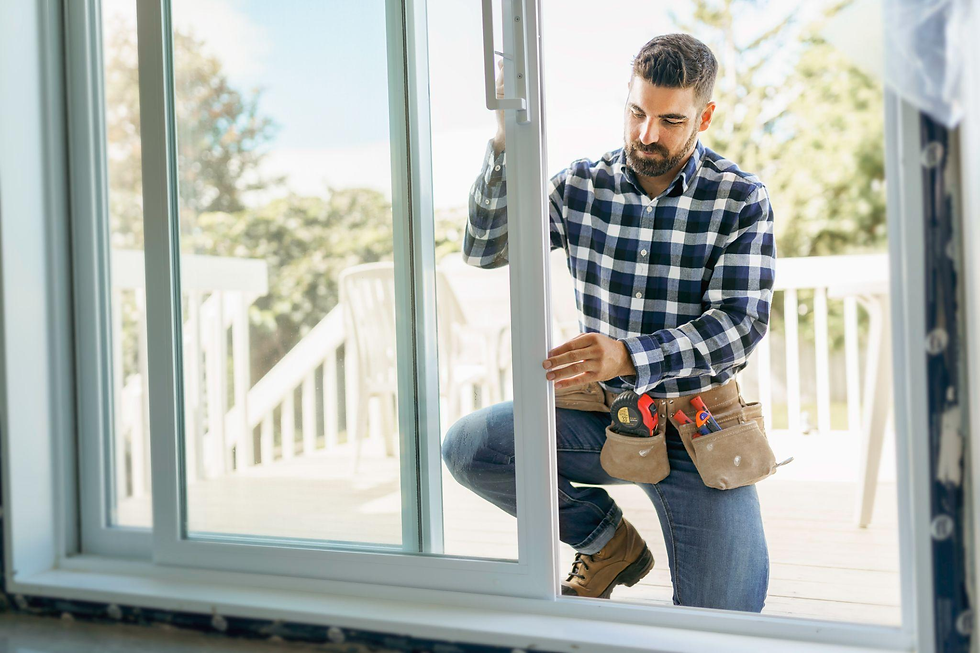Choosing the Right Door Designs to Complement Modern Interiors
- Staff Desk
- Aug 19
- 8 min read
Updated: Aug 22

We obsess over paint colors, furniture, and flooring, but what about the one design element we interact with every single day? Doors are often the last thing we consider, yet they have the power to make or break a modern aesthetic. Think about it—you touch your front door handle when you come home after a long day, you slide open your bedroom door every morning, and you push through your office door countless times. These aren't just functional barriers; they're architectural punctuation marks that either elevate your space or quietly undermine it

In modern design, doors transform from simple room dividers into integral architectural features that contribute to the overall clean, uncluttered, and sophisticated feel of a space. They're like the supporting actors in a great film—when done right, they enhance the entire performance without stealing the spotlight.
Making a thoughtful choice can enhance flow, save space, and add a touch of architectural elegance, tying your entire design scheme together seamlessly. It's the difference between a house that feels randomly assembled and one that whispers sophistication in every detail.
The Hallmarks of a Modern Door
Simplicity is King
At the heart of modernism lies a simple philosophy: "less is more." Modern doors embody this principle with clean lines, flat surfaces, and a deliberate absence of ornate decoration.
Imagine the difference between a Victorian door—with its raised panels, intricate moldings, and decorative glass inserts—and a sleek modern slab door. The modern version strips away all the visual noise, leaving only what's essential.
This isn't about being boring or stark. Rather, it's about creating a sense of calm and intentionality. When everything in your space has a purpose and nothing feels excessive, your mind can actually relax. It's like the design equivalent of a deep breath.
Traditional doors often feature complex panel configurations, carved details, and fussy hardware that demands attention. Modern doors, by contrast, become part of the architectural canvas rather than fighting for center stage. They work harmoniously with clean-lined furniture, minimalist art, and open floor plans.
A Focus on Function and Form
Modern design doesn't just prioritize how something looks—it demands that form follows function in the most elegant way possible. This means considering not just the aesthetic appeal of a door but how it operates within your specific space. Does a traditional hinged door make sense in a narrow hallway, or would a sliding door preserve precious square footage?
Smart functionality becomes especially important when you're working with doors for pros who understand that every design decision should solve a problem while looking effortless. The mechanism—whether sliding, pivoting, or folding—becomes as crucial as the door's visual impact in achieving that coveted modern feel.
Think about how a pocket door can make a small powder room feel more spacious, or how a pivot door can create a dramatic entrance that still maintains the clean lines essential to contemporary design. These aren't just trendy choices; they're intelligent solutions that modern living demands.
Popular Door Styles for a Contemporary Look

The Flush Door: A Blank Canvas
The flush door stands as the quintessential modern door—a single, flat, smooth slab that embodies everything contemporary design represents. It's beautifully straightforward, like a piece of minimalist art that happens to be functional.
Why it Works:
• Versatility: Can be painted to blend seamlessly with the wall for an almost invisible transition, or finished in a bold color or rich wood veneer to become a subtle statement piece. Imagine a charcoal-painted flush door against crisp white walls—it becomes architectural jewelry.
• Minimalism: Its simplicity creates a calm, uncluttered backdrop that lets other design elements shine. It's like choosing the perfect neutral foundation that makes everything else pop.
• Affordability: Often the most cost-effective option while still delivering high style impact. You're getting maximum visual payoff for your investment.
The beauty of a flush door lies in its restraint. It doesn't compete with your carefully curated artwork or distract from your statement lighting. Instead, it provides the perfect backdrop for modern living.
Space-Saving Solutions: Sliding and Barn Doors
These are perfect for modern homes where open-plan living and maximizing every square inch are paramount. Traditional hinged doors require clearance space that many contemporary floor plans simply can't spare.
Pocket Doors disappear completely into the wall cavity, creating the ultimate clean look when open. They're like magic tricks in door form—now you see them, now you don't. This makes them ideal for spaces where you want the flexibility to completely open up or close off areas, like between a kitchen and dining room.
Barn Doors, meanwhile, act as moving architectural features. The exposed hardware becomes part of the design statement, adding a touch of industrial or rustic-modern charm. Picture a sleek steel track system with a weathered wood door—it's the perfect marriage of raw materials and refined engineering that modern design celebrates.
The Pivot Door: A Touch of Drama
A pivot door rotates on a central point rather than traditional side hinges, creating a completely different opening experience. It's like the difference between turning a page and spinning a record—both functional, but one feels more dynamic and unexpected.
This style creates a dramatic, high-end entrance that feels both substantial and effortless. Pivot doors work especially well for larger or taller openings where you want to make a grand statement without sacrificing the clean lines that define modern aesthetics. When working with experienced Aspen interior designers, pivot doors often become the showstopper element that elevates an entire space.
The mechanism itself becomes part of the design appeal—watching a massive door glide open on a single point feels almost magical and speaks to the engineering precision that modern design values.
Glass Panel Doors: Light and Separation
Doors incorporating glass panels—whether frosted, reeded, or crystal clear—solve one of modern design's biggest challenges: maintaining openness while providing functional separation. They're perfect for borrowing light from adjacent spaces while still defining distinct areas.
These doors work beautifully for home offices where you want visual connection to the rest of the house, pantries that benefit from interior light, or walk-in closets where you want to showcase beautiful organization. The glass keeps spaces feeling connected and airy rather than chopped up and compartmentalized.
Consider how reeded glass provides privacy while still allowing light to filter through, or how clear glass maintains complete visual connection while providing sound separation. These doors for pros understand that modern living requires flexibility and smart solutions.
Materials, Finishes, and Hardware: The Finishing Touches
Material Matters
The material you choose dramatically affects both the door's performance and its contribution to your overall design scheme. Each option brings its own personality to the space.
Material Choices:
• Solid Core Wood: Offers substantial feel, exceptional sound insulation, and natural warmth that prevents modern spaces from feeling cold or sterile. Think rich walnut or clean oak that adds texture without visual complexity.
• MDF (Medium-Density Fiberboard): Provides a perfectly stable and smooth surface that's ideal for painted finishes. It won't expand, contract, or show grain lines, making it perfect for those crisp, clean painted doors.
• Metal and Glass: Delivers sleek, industrial, or high-tech aesthetics that feel distinctly contemporary. Steel frames with glass inserts can create stunning visual impact while maintaining modern principles.
The Power of Hardware
Hardware truly is the jewelry of the door world—small details that make an enormous impact on the overall impression. Modern hardware embraces minimalist and geometric forms that complement rather than compete with the door's clean lines.
Think of hardware as the punctuation in your design sentence. Just as a well-placed period provides clarity and finality, the right door handle provides the perfect finishing touch that ties everything together.
Popular finishes include matte black for dramatic contrast, brushed nickel for subtle sophistication, satin brass for warm elegance, or chrome for crisp modernity. The key is avoiding anything ornate, curvy, or that references historical periods. Instead, look for pieces that feel like they were designed by engineers who happen to have excellent taste.
Opening the Door to Modern Style
Choosing the Right Door in Modern Interior Design
Choosing the right door represents a crucial step in successful modern interior design. The selection of doors is not merely a functional decision; it is an opportunity to enhance the aesthetic appeal and coherence of your living space. In contemporary design, the key lies in prioritizing simplicity, clean lines, and intelligent functionality over decorative flourishes or historical references that may detract from the overall ambiance.
The Importance of Simplicity Simplicity in design allows for a more open and airy feel within a room. When selecting doors, opting for designs that feature minimalistic elements can create a sense of calm and clarity. Doors that are devoid of excessive ornamentation or intricate carvings can serve to unify the space, allowing other design elements, such as furniture and artwork, to take center stage. This focus on simplicity fosters an environment that feels both modern and inviting. Clean Lines and Geometric Forms Clean lines are a hallmark of modern design, and this principle should extend to the doors you choose. A door with straight edges and a sleek profile can contribute significantly to the overall aesthetic of a room.
Geometric forms not only enhance the visual appeal but also promote a sense of order and structure within the space. The integration of well-defined shapes can create a harmonious flow, guiding the eye naturally from one area to another. ## Intelligent Functionality Intelligent functionality is another critical aspect to consider when selecting doors. In modern interior design, doors should serve not just as barriers but also as functional elements that enhance the usability of a space. For instance, pocket doors or sliding doors can save valuable floor space in smaller areas, making them an excellent choice for contemporary homes where space optimization is essential.
Additionally, doors with built-in storage solutions or those that are soundproof can provide added benefits, making them both practical and stylish. ## Intentional Choices Every door in your home should feel intentional and purposeful, reflecting the overall design vision you wish to achieve. This means considering the material, color, and style of the doors in relation to the rest of your interior. For example, a sleek, matte black door can create a striking contrast against light-colored walls, while a natural wood finish can add warmth and texture to a modern space.
Each choice should be made with careful consideration of how it fits into the larger narrative of your home’s design. Seamless Integration Finally, the concept of seamless integration cannot be overstated. The doors you choose should not only complement the existing elements of your interior but also enhance the overall flow of the space. This can be achieved by ensuring that the doors align with the color palette, materials, and design language of the surrounding areas. When doors feel like a natural extension of the room rather than an afterthought, they contribute to a cohesive and well-designed environment. In conclusion, selecting the right doors is an essential aspect of modern interior design that should not be overlooked. By prioritizing simplicity, clean lines, intelligent functionality, intentional choices, and seamless integration, you can ensure that each door in your home contributes positively to the overall design vision. This thoughtful approach will ultimately create a space that is not only visually appealing but also functional and harmonious.
Remember that a door is both the first and last thing you interact with when entering and leaving any room. By choosing doors that reflect your home's modern character, you're not just closing off spaces—you're completing a comprehensive design vision that speaks to contemporary living at its finest. Each opening and closing becomes a small moment of design appreciation, a daily reminder that good design enhances every aspect of our lives.



Comments